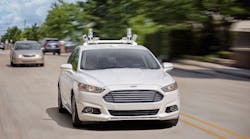Suppliers and other industry players need to evolve their organizations and their partnering approaches to successfully transition to a “new automotive ecosystem, according to a reported released on July 12 by AlixPartners.
Trends such as the connected, autonomous, shared and electric vehicles of the not-too-distant future are causing the auto sector to change directions and quickly. Companies that are relying on traditional auto-industry approaches are falling behind and why they should consider revamping their operating models.
This is especially important, the report says, as U.S. auto sales are forecasted to see a downturn to 16.9 million,light-vehicle units this year and to a cyclical trough of 15.2 million units in 2019 – partly driven by a “used-car time bomb” of 500,000 more off-lease vehicle-returns in 2017 vs. 2016, on top of the 500,000 more in 2016 vs. 2015.
For the last 11 months sales incentives in the U.S. have averaged more than 10% of vehicle prices – a historical harbinger of downturns, and that there’s a “used-car time bomb” about to explode in the market – 500,000 more off-lease vehicle-returns hitting the market this year than last, likely depressing used-vehicle prices double the 13% drop already since 2014, and costing automakers’ captive finance companies up to $5 billion.
This all, notes the reports, will likely be a double-whammy to new-vehicle sales, displacing sales to cheaper used cars while increasing lease payments on new vehicles as leases get written with anticipated higher residual rates and tighter credit standards.
On the autonomous-vehicle front, there are now more than 50 major companies are now working on autonomous vehicles or full autonomous-vehicle systems, as well as a plethora of smaller companies and start-ups. This “Wild-West” environment will likely result in a handful of big winners, says the study, but on the other hand, also many disappointed investors. The report also notes that many of the newer high-tech entrants have completely different “DNAs” than traditional automotive companies, including being used to very high returns on capital. Given the white-hot competition brewing, the analysis predicts that AV systems-costs could drop 78% by 2025.
On the shared-mobility front, the analysis includes a survey of a total of 2,000 US adult consumers that shows just how fast things are changing in today’s automotive world. The survey polled 1,000 consumers across 10 large markets where both car-sharing and ride-sharing are popular (the metro areas of Austin, Boston, Chicago, Los Angeles, Miami, New York, Portland, Seattle, San Francisco-Oakland and Washington, D.C) and, as a control group, 1,000 respondents across the entire U.S.
This mirrored a consumer survey by AlixPartners in November 2013. In this year’s survey, consumers in the 10 trend-setting markets said their awareness for virtually all major car-sharing brands (names such as Zipcar, Car2Go and Enterprise CarShare) has decreased, and 21% of respondents were unable to name any brands at all.
On the connectivity front, the analysis points to the example of Tesla Inc.’s “high-spec” center-stack display, featuring over-the-air upgrades from the company and iPad-like features. Though this feature has been on the market since the 2012 model year, and has garnered very strong reviews from consumers, no other major automaker has moved to match the system.
Ride-Sharing
The survey asked users of ride-sharing (brands like Uber and Lyft) in the 10 markets (named above) about their intended usage in the next 12 months vs. their past usage, and 24% said their usage would be or more than in the past, vs. just 5% who said less – an 18-percentage-point difference.
Meanwhile, just 17% of car-sharing users surveyed in those markets said they’d employ car-sharing more in the coming 12 months than in the past – vs. 16% who said they’d use that mobility service less in the year ahead.
Moreover, among respondents in the 10 markets, the survey found that ride-sharing was five times more likely to be a top-three transportation mode than was car-sharing (11.6% vs. 2.5%), and three times more likely than traditional taxis (11.6% vs. 4.2%). In addition, among millennials surveyed in the key markets, 9% said ride-sharing has allowed them to postpone or avoid getting a driver’s license – another indicator of today’s fast-changing times.
Another key finding of the survey is that in the 10 key markets each vehicle used in car-sharing is likely replacing the need for 19 personal vehicles -- a decrease from 32 vehicles based on the results from AlixPartners’ 2013 survey. Meanwhile, according to the same analysis, one vehicle used ride-sharing is likely displacing four personal vehicles. The report goes on to note that both ride- and car-sharing vehicles are typically replacing vehicles driven less than 5,000 miles per year, not typical commuting vehicles.
Electric Vehicles
China is investing heavily to take a leadership role in electric vehicles. In an example of that, the report notes that Chinese automakers commanded 96% of the 2016 market in China for full electric vehicles (not including hybrids), more than double their share (43%) for all types of light vehicles. It also finds that of the 103 EVs to be launched globally by 2020, 49 of them will come from China-based automakers The report additionally predicts that China is targeting to have two-thirds of the world’s manufacturing capacity for lithium-ion batteries by 2021 (175 GWh of power, or the equivalent of five Tesla “giga-factories”).
Meanwhile, the report notes that hybrid sales in the U.S. have slowed, from 3.2% of the market in 2013 to just 2.1% so far in 2017, while plug-in and battery-electrics sales, while increasing, still represent only 1.0% of the market. This, says the study, underscores the need for maximum flexibility in both organizations and partnerships to handle the expected, but bumpy, shift to the new automotive ecosystem that’s coming



